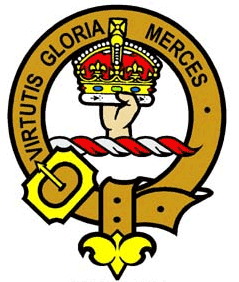Robertson Clan
Robertson Clan Crest: A dexter hand holding up an imperial crown.
Robertson Clan Motto: Virtutis Gloria Merces (Glory is the reward of valour).
History of Clan Robertson (Donnachaidh):
Donnachaidh Reamhair, otherwise Duncan, a descendant of the Royal House of Duncan through the Celtic earls of Atholl, was the ancestor of this Clan which came to prominence in 1306 when Robert the Bruce was defeated
at the Battle of Methven, near Perth, and fled into Atholl for protection. The Clan fought at the Battle of Bannockburn in 1314, and Duncan's son was called Robert after the King. It is from him that the Robertson
surname originates.
In 1437, Robert Riabhach, 4th Clan Donnachaidh Chief, captured the Master of Atholl and Sir Robert Graham, who had murdered James I at Perth. As a reward, James II gave him a Charter to his lands which stretched from Perth, encompassing the landscape around lochs Tummel, Rannoch and Tay. Thereafter, the Clan adopted the name Robertson, although some clansfolk took the name Duncan; others Reid, after a red-headed son of the Chief.
For three generations, the Robertsons feuded with the Stewarts of Atholl and their neighbours, Clan Menzies, and a large proportion of clan lands was sold off to cover debts. Over this period, Robertson territory was infiltrated by persecuted MacGregors from the West and cattle thieves from the North.
The Robertsons followed the Jacobite Cause with devotion. They supported the Marquis of Montrose and fought at the Battle of Inverlochy. The young Robertson Chief Alexander was at St Andrews University when James VII went
into exile. A talented poet, he wrote in English, French, Gaelic, Latin, Italian and Greek, but he was also a man of steel and fought in the Jacobite Uprisings of 1688, 1715 and 1745. As an old man he watched
his Clansmen join in the rout of the Redcoats at the Battle of Prestonpans and drove home in the captured carriage
of General Cope. When he died in 1749, 2,000 men marched fifteen miles behind his coffin to the Clan Burial Ground at Struan.
However, after the 1745 Uprising, Clan Donnachaidh lands were forfeit and when they were eventually reclaimed by Alexander, 15th Chief, son of Duncan Robertson of Drumachuine, finances were in a poor state and many of the clansmen had drifted away to the Lowlands and onwards across the seas to the New World. It should be emphasised that this was voluntary. No clansman in Atholl was ever forcibly evicted over the period that became known as the Highland Clearances.
The Clan Donnachaidh Society was launched in 1823, and now has seventeen overseas branches. A Clan Donnachaidh DNA surname project has been launched with the FamilyTreeDNA Testing Laboratory in Houton, Texas.
William Robertson (1721-93) was son of Minister of Old Greyfriars, Edinburgh. He became Principal of Edinburgh University and furthered plans for Old College.
James Patrick Robertson (1845-1909) was Solicitor General for Scotland, then Lord President. He became Lord Robertson of Forteviot.
Sir Hugh Roberton (1874-1952) was born in Glasgow and founded the Glasgow Orpheus Choir.
Adam Duncan (1731-1804) was born in Dundee and became a British Admiral, taking command of the North Sea Squadron to watch the Dutch Fleet. In 1797, he won a brilliant victory at Camperdown and was created Viscount Duncan of Camperdown. In 1831, his son was created Earl of Camperdown.
Henry Duncan (1774-1846) was a Scottish Clergyman who in 1810 established in Ruthwell, Dumfriesshire, the first Savings Bank.
Thomas Duncan (1810-45), born in Perthshire, became a distinguished Scottish painter.
Sir Thomas Reid (1710-96) was head of the Scottish School of Philosophy.
General John Reid (1721-1807) changed name from Robertson to Reid on inheriting the Straloch estate inPerthshire. He composed The Garb of Old Gaul and endowed a Chair at Edinburgh University.
Sir William Reid (1791-1858) became Governor of Gibralter, the Windward Islands and Malta. Sir George Reid (1841-1913), born in Aberdeen, a portrait and landscape painter, became President of the Royal Scottish Academy.
Sir George Houston Reid (1845-1918) went to Australia at the age of seven and in 1904, became Premier of Australian Commonwealth.
In 2003, George Reid, born near Alloa in 1939, became the second Presiding Officer of the Scottish Parliament.
Surname distribution in Scotland: The highest concentrations of the Robertson name occur in Shetland (Zetland), Perth and Kinross (Perthshire and Kinross-shire), Highland (includes the historic counties of Caithness, Inverness-shire, Nairnshire, Ross and Cromarty and Sutherland), the Orkney Islands, Aberdeen City, Aberdeenshire (includes all of the historic counties of Aberdeenshire, Kincardineshire and part of Banffshire), Moray (including most of historic Banffshire), Dundee City, Angus (Forfarshire) and Fife.
Places of Interest:
Clan Donnachaidh Museum, Bruar Falls, Pitlochry, Perthshire. Clan Donnachaidh Headquarters.
Moulin Churchyard, Robertson burial ground, Atholl, Perthshire. A tombstone in the kirk yard
shows the Robertson arms with a captive man under the shield, the Robertson chiefs were granted the rare distinction of an extra supporter on the crest to commemorate their capture of the James I’s killer in 1437.
Associated family names (Septs): Collier, Colyear, Connochie, Conochie, Cunnison, Dobbie, Dobbin, Dobie, Dobieson, Dobinson, Dobson, Donachie, Donaghy, Duncan, Duncanson, Dunnachie, Hobson, Inches, Kynoch, MacConachie, MacConchie, MacConich, MacConechy, MacConnochie,MacDonachie, MacGlashan, MacInroy, MacIver, MacIvor, MacJames, MacLagan, MacCullich, MacOnachie, MacRobbie, MacRobert, MacRoberts, MacRobie, MacWilliam, Reed, Reid, Robbie, Roberts, Robison, Robson, Roy, Stark, Tynnochy.
Robertson Clan members display Prints.

